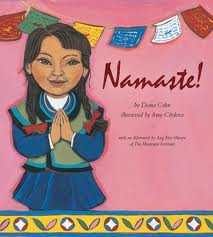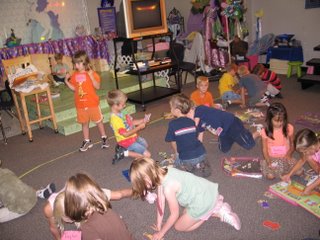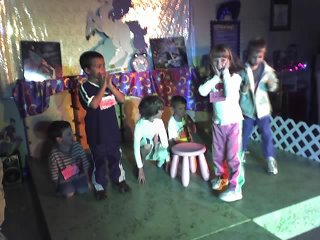|
Kindergarten
Kindergarten will have three main projects:
1. Make masks.
2. Read the book Namaste and create short puppet shows with the puppets saying it to each other.
3. Act out a short story as a class and then, if desired, in small groups
 MASKS MASKS 
The masks will be an unstructed activity as part of Theatre Centers on Fridays. Outlines of Himalayan style masks will be copied onto cardstock. Pictures of actual masks will be available for them to see, as well as a mask from Nepal. Students will color them, cut them out, and tape them to a sentence strip that has been sized to fit their head and taped. They will be taught how to cut out the eye holes in kindergarten by folding the place you want a hole, making a snip, putting the scissors in that and then cutting around the opening.

ACTING
- Teacher will read or tell theJataka tale about the rabbit that thinks the earth is splitting apart. In Buddhist Animal Wisdom Stories it is called "The Panicked Rabbit." It is similar to Chicken Little except that there is no plan to tell the king and that the animalsdon't get eaten at the end.
- Students can be directed to stay in place and imagine they are walking and then running in place or they can move about the room. If it's not a large open space, they can run in slow motion.
- The teacher will then lead them all acting out the story at the same time starting by imagining they are rabbits sitting under a fruit tree. Just as they are thinking about what they would do if the world split apart, there is a noise that sounds like it is really happening. Practice acting the reaction. How does a rabbit move differently than a person?
- Then have them pretend they are the first animal that sees the rabbit. What animal is it? How does that animal move compared to a rabbit? What do they think when they see the rabbit? What do they say? Practice it. Then what do they do?
- Now pretend you are the next animal, and so on, until you get to the lion.
- Practice moving like a lion. What does the lion think when s/he sees all the animals? What does s/he say?
- Who goes back to the tree? How can we pretend the rabbit is riding on the lion? (maybe it's a puppet)
- Who tells the animals what really happened?
- Practice this in the whole group and then maybe half the class doing it for the other half.
- Then if desired, have them rehearse and then perform in groups with each person only having one part. The others could sit in the audience or actually be the large groups of animals that don't talk.
- Discuss which part was more fun, what went well, what do we need to work on, etc.
|


 MASKS
MASKS 
